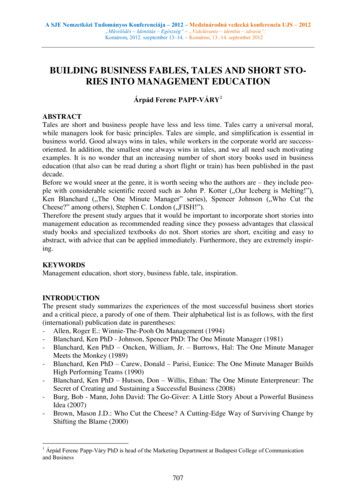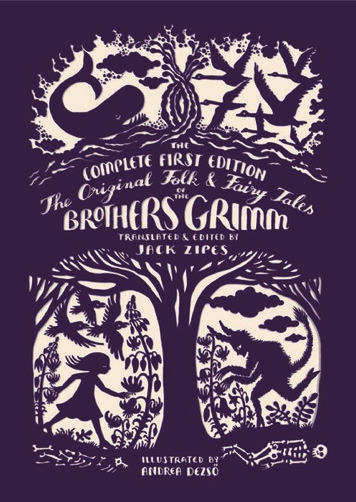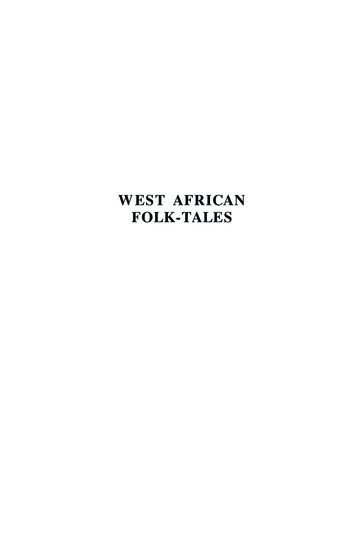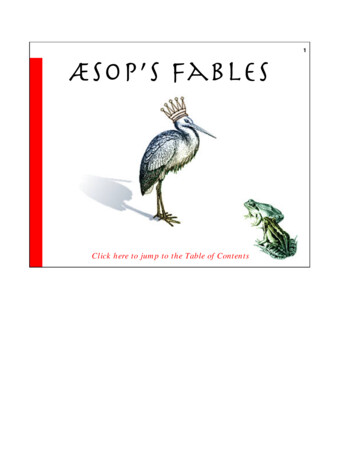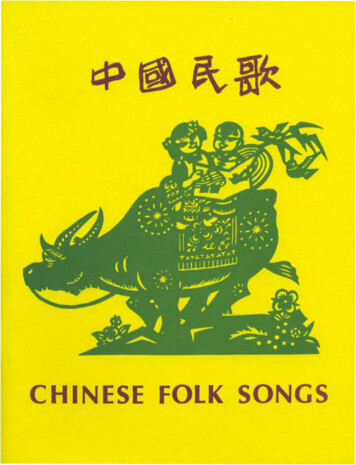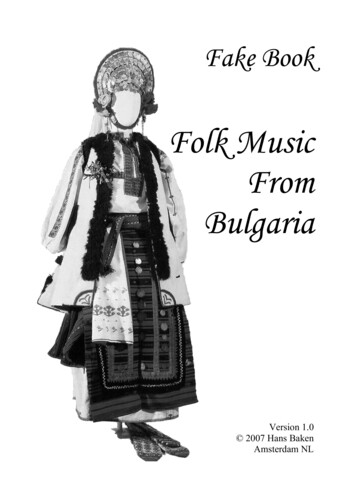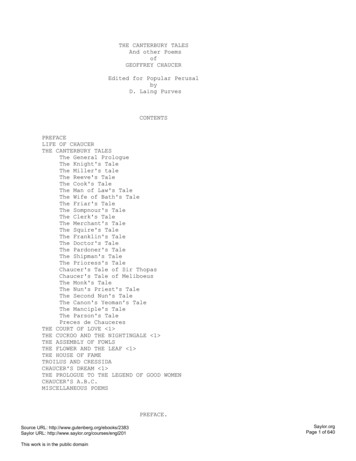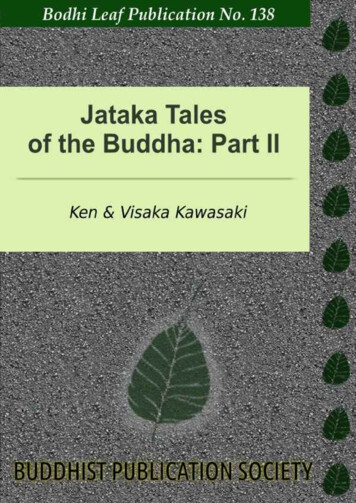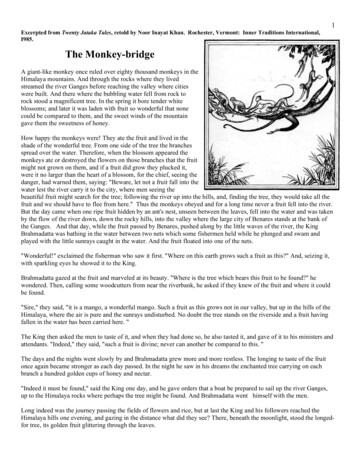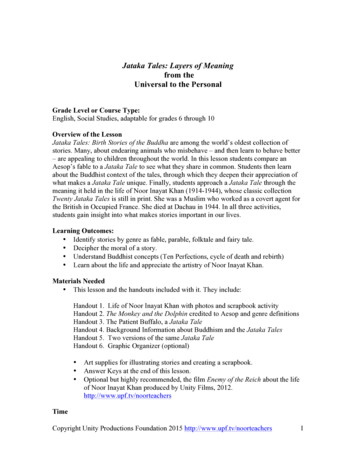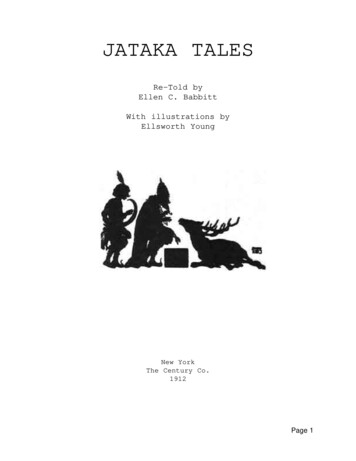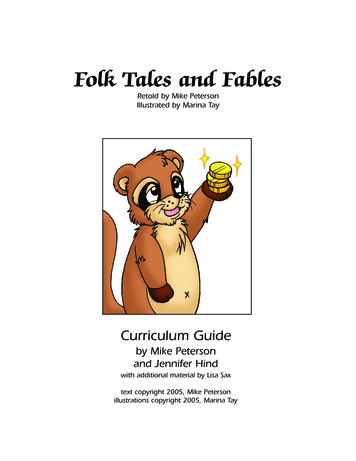
Transcription
Folk Tales and FablesRetold by Mike PetersonIllustrated by Marina TayCurriculum Guideby Mike Petersonand Jennifer Hindwith additional material by Lisa Saxtext copyright 2005, Mike Petersonillustrations copyright 2005, Marina Tay
IntroductionThe stories in this series were collected from authentic folklore sources in the public domain.In making the selections, I tried to find well-researched stories that required minimal changesto conform to the tastes and sensibilities of a modern audience, and that brought with thema sense of old-fashioned story-telling. While some required more editing than others, I didnot change any plot points or important elements of any of these stories.It is a diverse collection, not just in terms of the nations and cultures represented but alsoin the tone and mood of the stories. Some, like “The White Dog,” (Latvia) have elementsof a traditional European fairy tale. Our two Japanese stories are more philosophical, eachin its own way. Two of our African stories are mostly fun -- the forerunners of the BrerRabbit stories -- but “How The Hawk Chose His Food” is a fable that Aesop might haveenvied. And the tales that actually include fairies are much more bittersweet than mostmodern readers would expect.Back in my reporting days, Arlo Guthrie remarked to me in an interview that, after all,“Folk songs are just songs that folks sing.” He was unconcerned about whether a songwas 200 years old or written by the Beatles, and defined folk music by its acceptancerather than its origins.By the same token, these stories are united not by theme or country of origin or age, butbecause they have been accepted by the people who tell them. It is this appeal that keepsstories alive, and, for modern readers, is the difference between an old story read for scholarlypurposes and one which happens to be old but contains an appealing, engaging sense ofuniversal wisdom, warmth and truth. I’ve gone through many, many stories looking for folktales and fables that your students will enjoy and that will spark lively classroom discussions,and I hope you like the selection.This guide contains lesson ideas and exercises you may apply to any of the stories, as well asspecific material for use with each story. In the end, however, your use of these fables andfolk tales in the classroom, like your use of the overall newspaper in the classroom, will belimited only by your imagination.If you come up with a lesson plan of your own that works particularly well, I hope you’llshare it with me. We’re all here to learn!Mike PetersonProject editorteachup@gmail.com
FOLK TALESANDFABLESIntroduction to the genre: How to introduce folk tales to your studentsFolk Tale ElementsInformation and lesson plans about elements characteristic of folk tales. Specific activitiesand instructional strategies to teach about each of the elements.*Character Development*Setting*Plot and ThemesCritical AnalysisTeaching students to analyze and interpret folk tales through a critical lens. Developan understanding of social development, cultural implications and trends in literature.Skill-based InstructionUsing the folk tales to teach a variety of skills such as decoding, fluency, oral presentationand grammar.Creative Writing ProjectUse the folk tales to teach styles of writing such as persuasive, descriptive andnarrative in a fun and educational format -- a newspaper!Cultural studiesLearn more about the various countries and cultures from which the stories come.The Individual Stories: Writing, Reading, Listening & SpeakingLessons, activities and strategies based on individual folk talesThis guide is designed for use by 3-8 grade level classroom teachers who are introducing a unit of studyon folk tales. The content and suggested activities are meant to be adapted and modified to suit theneeds of the intended audience, including younger students who may need more help in reading andunderstanding the stories. All activities and instructional strategies included in this manual are basedon effective teaching models, state- and national- standards and research-based literacy instruction.The reproducibles are designed for use with individual stories and can be introduced at any stage of thisliteracy unit depending on the established goals and objectives.The suggested overview for this unit is intended to help teachers develop a flexible curriculum plan thatcan be tailored to the amount of time allotted for the unit. Rather than defining the unit of study by useof a timeframe, the unit is structured by a variety of components.
FOLK TALESANDFABLESIntroduction to the genre: Folk TalesThe following activities are suggestions of how to introduce folk tales to students: Write the words “Folk Tale” on an overhead and create a K-W-L Chart todiscuss the topic. (A K-W-L chart is a three-column vertical chart with theheadings: K for what you know, W for what you want to learn, and L forwhat you have learned. The L is completed after the unit of study to determine the learning outcomes.) Dress up as a character from a popular or common folk tale such as “LittleRed Riding Hood” and ask students to guess who you are. Prompt themto brainstorm and list other folk tales, like Paul Bunyan, Jack the Giant Killer orsome local “monster” said to live in a local lake or forest, Create a classroom chartof familiar tales to reference during class discussion. Visit the library and create a display of folk tale books. Ask students toname the genre that is common for all of the books. Create a folk tale survey and discover what students already know aboutfolk tales. Using survey information from whole class create a graph todisplay the responses. Explain to students that you will be introducing a unit on folk tales andassign them the task of using the Internet to gather information (at leastone fact or example) about folk tales. Be sure to document the URL forfuture reference. Write on index card and create a folk tale tree of facts.The Only Folk Tale Web Sites You Will Ever Need!The most useful Web site for locating original texts that we found is called “Sacred Texts”and contains a variety of sources of wisdom from around the world. (It doescontain information on world religions, but also a vast collection of non-religious folktales from every nation and era)www.sacred-texts.comDo Not Miss This Resource!The teaching guide, “When Tortoise Wins: Using International Folktales to TeachLanguage Arts,” (PDF) is part of a massive, wonderful site at the University ofPittsburgh for teaching about ethnicity and diversity. You’ll be back here often!http://www.ucis.pitt.edu/pehsc/index files/fpframe files/lessons.html
FOLK TALESANDFABLESCharacter Development Use the following suggestions with any story from the series . Create a master character chart and categorize each of the characters by traitsand types. For example, list the title, character and types such as: human, animal,hero, villain, trickster, fairy, etc.(See Appendix for character chart) Select one character to create a profile for. Draw an illustration of thecharacter and list adjectives to describe. For each adjective, use a thesaurus tolist similar adjectives. Adopt the point of view expressed by one character and write a letter toanother character within the same story. Select a story and divide students into small groups. Assign each group onecharacter to explore. Based on the plot and the students’ understanding of theassigned character, rewrite the story exclusively from the point of view of theassigned character. Select a character from one story to compare and contrast with a characterfrom a second story using a Venn Diagram. (See Appendix) Write a story tale from the perspective and point of view of an objectwithin the story. Develop the object and give it human qualities and traits. Choose a character that is similar to yourself and explain your choice. Select a character and discuss how the character changes from the beginningto the end of the story in terms of appearance, attitude and social status. Select a character and create a biopoem (See Appendix) Play character charades. Have students draw random cards and improvise adramatic mime for the audience to guess what character is being portrayed. Another version of roleplaying: Have students draw a character card and beprepared to answer questions from classmates as they interview the characterin order to guess who is being represented.
FOLK TALESANDFABLESSetting Use the following suggestions with any story from the series . Create a master setting chart and categorize each of the settings of eachstory: castle, jungle, village,etc. Compare and contrast settings from several story. Identify the place where the story originated. Conduct research on that locationand explain the elements of the story that seem typical of that place and culture. Read the story and highlight words and phrases that help describe the setting. Create a diorama for the story depicting the setting. Draw a picture that describes the main setting of the story.Plots and Themes Create a master plot chart and categorize each of the plots/themes of eachstory: bad luck, impossible task, a villain, a trickster, a magical helper, magic spells,rewards of wealth and/or marriage, hero or heroine in danger or treatedbadly, etc. Use bookmark strategy to develop plot understanding (See Appendix). Plot development conflict report (See Appendix) After reading the series select a story to dramatize, or divide into groups and haveeach group dramatize a different story. Conduct a mock trial relying on plot details. Have students create skits based on the plot and have audience identify ifthe skit depicts the action of the beginning, middle or end of the story. Create a debate chart of ethical issues related to the plot. One column reads“YES” and the other side reads “NO.” On each side have student list statements related to the story arguing for or against a plot action. Use a story mapping chart to record information related to the plot (SeeAppendix).
FOLK TALESANDFABLESCritical Analysis Analyze and interpret a story that comments on a social attitude.Compare the theme with a modern situation. Write an essay illustratinghow the themes are similar. Find another story from the same culture or region and compare theircommon elements, using the Venn diagram in the Appendix. Explore similarities and differences in traditions and symbolism that existin cultures around the world as expressed within the story. Select a storyand discuss how it would be written differently based on cultural implications. Select a story and discuss the gender roles. Analyze the gender roles anddiscuss the implications. Go to the library and select a contemporary non-fiction book thatdiscusses the treatment of males and females, gender bias and stereotypicalimplications. Choose an issue raised by the book and relate it to a storyby examining issues such as stereotyping and gender bias. (If you areworking with older students you may want to provide students with titlessuch as: Mary Pipher’s “Reviving Ophelia”). Critically analyze a story in terms of ethical issues. Discuss the issue, themoral or ethical dilemma and take a position for or against the action taken. Select a recurring theme embedded in these stories and discuss thepresence of that particular theme in modern movies and television. Discussthe theme, the story, the movie or television show in terms of how artimitates life or vice versa. Select a story and pretend you are turning it into a live-action Hollywood film.Choose the actors you will cast in the various roles. Discuss and defend yourchoices as if the class were a committee planning this film. Analyze any trendsthat emerge in this discussion and talk about the decision to be realistic or idealisticin casting. Analyze for trends involving weight, hair color, ethnicity. As a group,come up with your final casting decisions. Analyze the rewards acquired by the hero or heroine. Describe the underlyingphilosophy and moral of the story. Relate it to your own views and write acritical analysis of related topics such as: intrinsic vs. external motivation, workethic, good and bad luck, etc.
FOLK TALESANDFABLESSkill-based Instruction Select a story to analyze for the use of imagery styles. For example,record and explain the use of simile, metaphor, onomatopoeia andpersonification. Create similes and metaphors to describe characters and actions of a story. Select a story and rewrite sentence beginnings by using:adjectivesadverbial phrasesadverbsnounsparticiples Review a story and highlight or circle assigned parts of speech andgrammar. (Ex. adverbs, adjectives, nouns, compound and/or complexsentences.) Create a script of the dialogue between characters in a story. Be sureto use the proper mechanics and conventions. Create a rubric for stories with categories such as: use of commonelements characteristic of stories, content and details, and grammar andmechanics. Review a story and create a list of vocabulary words that are unfamiliar.Use the dictionary and define each word. In pairs of two, create a vocabularyquiz to administer to your partner. Brainstorm a list of adjectives to describe a character or setting of a story.Using a thesaurus list antonyms, synonyms and homonyms. (A good bookto introduce this activity is “The King who Rained” by Fred Gwynne). Write a business letter to a character involved in the story using theproper style for letter-writing. Select at least ten words from a story. Have students look up the wordorigin, and dissect in terms of root word, prefix and suffix.
Folk Tales and FablesSPLIT DECISION: Robin Hood outshoots Gisbourne on final arrow - Sports, D1THE WEATHERWEEKDAYT H ESeptember 14, 1354TIMES-FANTASY97th Year, No. XXXNewsstand price 1 silver pieceCold, with achance oftanukis. Details, Page AxFinal EditionQueenstown, CastlemainYour Hometown Newspaper since the dawn of timewww.pickafairytale.comCreative Writing Project-- Folk talesDeck hed tells a little more, provides another reason for you toread this storyUse a story from theseries to create athematicnewspaperBy T.J. DestryStaff Writeryourname@folktaleland.comThis project, acomplete English LanguageArts experience, involvesusing knowledge ofnewspapers to create a thematic story newspaper. Itcan be completed as awhole class project, insmall groups orindividually.As an introduction tothis project, supply yourstudents with newspapers.Discuss the various sections and features such as:*Front page*Classified Ads*Display/Retail Ads*Sports Section*Editorial Page*Editorial/PoliticalCartoons*Opinion Columns*Advice Columns*Arts andCUTLINE: A cutline is named that because photos and other graphic items were once called “cuts.”This is probably because they had to be placed in “cut out” sections on the page separately from themetal type that made up the copy. If there are fewer than five people, the cutline should tell you eachof their names. Photographers must remember to get this information when they are taking pictures!Cutlines give brief information about what is going on the photo or graphic. Have your students createillustrations from a story and exercise writing brief cutlines describing the event or setting.Entertainment*Local, National andInternational News*Obituaries*Comics Section*Reviews.Movie,books, restaurantEnglish LanguageArts Standardsaddressed withthis project.By Ace WordsmithStaff WriterDiscuss the various writing styles and their distinctions:-Hard News Stories-Feature Stories-Editorials-Opinion ColumnsANY TOWN -This ELAproject incorporates nationaland state standards.Students will read, write,listen, and speak for:information and understanding,literary response and expression,critical analysis and evaluation, and social interactionSEE “STORY FACTORS,” PAGE A5GOOD MORNING! [09/14/54]HOME DELIVERY222-2222618134 200502CLASSIFIED sified.E2-10Calendar.SceneComics.D4Dear Abby .D2Hometown.B2Horoscope.D2Local LOCALThis box tells you a little bitabout a local story youmight want to read. The storyitself is on PAGE B1Students cancreate theirown art workor use a digital cameraand thecomputerBy Ace WordsmithStaff WriterANY TOWN - Have yourstudents write a hard newsstory using the inverted pyramid structure to answer the5W’s and How.“I suggest using quotes andproper grammar to truly createa strong writing piece,” hesays.“I also recommend a lessonon lead writing,” she added.Look through your newspaper and clip effective leads.Leads entice readers to continue reading.Hard news stories differfrom features stories in several ways. Have your studentsdevelop an example of bothusing a story for information.THESCENE
Folk Tales and FablesCreative Writing ProjectO-Students will identify parts of a newspaper.-Students will become familiar with theinverted triangle style.-Students will write creative pieces using avariety of writing styles such aspersuasive, narrative and informative.-Students will create illustrations toaccompany a piece of writing.-Students will use word processing skills tocomplete the assignment.-Students will design a front-page based ontheir knowledge of newspapers.-Students will distinguish between fact andopinion.BJECTIVESEditorial ---IF-Students will create an advertisement usingbasic design elements.-Students will use relevant sources to write aneditorial.-Students will use supporting details to supportthe main idea.-Students will use the writing process tocomplete creative writing pieces (pre-writing,revision, editing.)-Students will listen respectfully as othersshare their work.-Students will orally present creative writingpieces.Classified Ad --YOU WANT A DRINK, DANCE FOR IT!Last week, our community saw an example ofeveryone working together for the common good.Perhaps we shouldn’t be surprised that we also sawan example of someone taking advantage of thework of others.The current drought has been hard on everyone, sowhen the animals got together to dance down theriverbed until water emerged, it was an example to allof us. Predators and herbivores can work together!But there is always one bad apple, and we learnedthe next day that Hare once more found a way toget what he wanted without lifting a finger to help.We need more patrols at the new waterhole to guardagainst those who could be part of our community ifthey would put half the effort into helping out thatthey put into finding ways to cheat the system.Features Story --MILLERSTOWN - Knowan unusual boy’s name? Itcould earn you a gold coin!The queen is holding aspecial contest, in whichsubjects are invited to submit strange names for boys.If you come up with aname she’s never heard of,she’ll present you with acoin made from the famousgold she spun from straw,back before she marriedHis Majesty!8Lost -- Double-bit ax. Twenty-fivefeet long. Last seen at the sawmill.Contact P. Bunyan for reward.Hard News Story -ARGIVE BEACH - Talks remainedstalled between Greek military leadersand superstar-warrior Achilles, leavingthe seige of Troy in limbo.Achilles walked out 10 days ago ina dispute over the division of spoilsfrom a recent raid.Patroclus, agent for the invincibleson of Peleas, said “Achilles justwants what he was promised. Theycan resolve this anytime simply byfulfilling the terms of his contract.”But Menelaus, speaking for theArgive leaders, said there will be nocompromise on what he called a“demand for a spontaneous bonus.”“Achilles is a valued member of ourteam,” he said, “but I guess he’ll haveto sit sulking by the ships. We can’tdelay the war forever over one man.”
FOLK TALESANDFABLESCreative Writing Project (Continued)After students have become familiar with the parts, sections, functions and news style writing, engagein creating a newspaper using an individual story or several.Have students write several pieces modeling news style writing using the writer’s workshop modelof instruction. After a series of pieces has been compiled, students will use computer skills to finalizethe project. Depending on the age- and grade- level, resources and time available, students mayenhance their newspaper by adding graphics. Although many options exist, a basic thematicnewspaper should include several of the following elements:1 - Hard News Story based on the story using quotes, a strong lead andwritten using the inverted pyramid structure2 - An Advice Column with a relevant question based on a dilemma fromthe story. The question and answer should relate to the tale and beconsistent with the characters’ perspective3 - A Features article that relates to an aspect of the tale. Topics mightinclude fashion, food, health, how-to or celebrity interview.4 - A Display Advertisement for something related to the story usingthe basic principles of design5 - At least one classified advertisement. Must relate to the tale and bebrief in content, but other ads based on well-known stories may fill outthat part of the newspaper.6 - An editorial written for or against using the conflict, dilemma orresolution of the tale.7 - An editorial cartoon related to the conflict or resolution of the taleAdditional possibilities.An obituary for a character or objectHoroscopes for the charactersOpinion columnSports storyBusiness storyMovie, Book, Restaurant Reviews
FOLK TALESANDFABLESCreative Writing Project (Continued)The following background information is designed to help you teach aboutnewspapers.Front page -- Typically the front page covers the most important news. The decision of what toput on Page One is made during meetings. The most important news is located above the fold inbroadsheet newspapers (papers that are folded horizontally). The front page of a newspaper containsinformation such as the name of the paper, its year of origin, the date and often an index.Classified Advertisements -- These ads are within the classified section and are listed by categories(classifications) such as homes for sales, automobiles, help wanted, lost and found, etc. They arebrief and contain information such as telephone numbers, cost, salary, etc.Editorial Page -- The editorial page contains commentary, usually in the form of columns, editorialcartoons and an editorial.Editorial -- An editorial is an opinion piece that tells how the people who run the newspaper feelabout an issue. Editorials appear on the editorial page, but, unlike columns, do not give thewriter’s name, because they represent the entire newspaper and not just one person.Editorials have several functions:(1)To interpret(2)To influence action(3)(4)To praise or commendTo entertainEditorials often use persuasive writing to convince others to adopt a view or belief. Persuasivewriting often involves three basic steps. First, the opinion must be stated. Second, the opinionneeds to be supported with convincing reasons and concrete evidence. Third, the body of theargument should end with a conclusion which can be a prediction, a summary, or a call to action.Good editorials:*Get to the point quickly*Reflect logic*Make the reader think*Use plain language*Use anecdotes, examples, statistics, and facts to support the argument
FOLK TALESANDFABLESCreative Writing Project (Continued)The following background information is designed to help you teach aboutnewspapers.Editorial/Political Cartoons -- Editorial cartoons are graphic illustrations that provide commentary on an issue through the use of elements such as symbols.Display/Retail Advertisements -- These are ads for goods and services. They arelocatedthroughout the newspaper except on the front page. These advertisements contain pertinentinformation such as telephone numbers, store hours, sale prices and location of the business ororganization. Ads may contain graphic illustrations and/or photographs. They vary in size andshape.Sports Section -- Usually the sports stories found in this section are written usingdescriptive language and often literary styles such as similes, metaphors, etc.Opinion Columns -- Opinion columns are written by individuals and may not necessarilyrepresent the views of the editorial board. The opinions expressed in the columns are those ofthe individual column writer.Feature Writing --Feature articles are written pieces that are not considered hard news. Theymay be timely if written as a review or highlighting an upcoming event or production but theyare usually stories that do not contain “breaking news.” Features stories are often human interest articles and sometimes are strictly informational and process oriented. For example, a storyabout backyard decks may include a how-to section.HeadlinesA headline tells what the story is about. It uses big letters and just a few words so readers candecide quickly if they are interested in the story and want to read it.Inverted Pyramid Writing StyleThe inverted pyramid style of writing involves writing the most essential details andinformation at the top and less important details in later paragraphs. The questions answeredare often referred to as the 5 W’s and How -- what, who, when, where, why and how.Obituaries:An obituary is a notice placed by a funeral home to announce someone’s death. Until recently,obituaries were considered news and, at most newspapers, subject to the same rules as anynews stories. Each newspaper had its own style (rules) about things like what terms could beused, how many surviving relatives could be listed and whether or not hobbies and interestscould be mentioned. Today, many papers consider obituaries a type of ad. Families pay to haveobits in the paper, but, in return, they can make them much more personal than in the dayswhen they were “news items.”
STORY SOURCESSome stories required more recasting that others. In some cases, it was necessary to cobble parts of storiestogether, while in others, we added more explanatory text that would not have been necessary for anaudience of the time when the stories were originally collected and published. But some others could bepresented with very few changes. Here are the places we found most of our stories. Many can be foundeither at Project Gutenburg ( www.gutenburg.org ) or at Sacred Texts (http://www.sacred-texts.com)If your students are particularly taken with a story, it may be worth looking for these collections on-line tosee what other stories they might enjoy. Be forewarned, however, that we really chose the most appropriatestories. You may find that others are fragmentary, violent, explicit or otherwise not in keeping with currenttastes. (A few might even strike your students as boring.) Remember that folk tales are not necessarilycreated with young people in mind -- and that most originated before there was a sense that youngpeople ought to be sheltered from the earthier elements of life!The Kildare Pooka is based on a story retold by Patrick Kennedy in W. B. Yeats’ collection, “Fairy andFolk Tales of the Irish Peasantry” (1888)“Lion and Jackal” was compiled from several Bushman and Hottentot stories collected in SouthAfrica by James A. Honey for his 1910 publication, “South African Folk Tales.”“The Water Dance” is adapted from a Bantu story collected by Alice Werner for “Myths and Legendsof the Bantu,” 1933.“The Fairy Wife” is adapted from several versions of the story. One of these is found in “The WelshFairy Book” by W. Jenkyn Thomas [1908]“The Nis and the White Mare” is primarily adapted from “Folk-Lore and Legends; Scandinavian, byVarious, Edited by C. J. T., Translated by C. J. T.”, found on Project Gutenburg“Taffy and the Golden Harp” is adapted from “Welsh Fairy Tales” By William Elliot Griffis, 1921“The Dog, The Cat and The Mice” is adapted from a story in “Rumanian Bird and Beast Stories” byM. Gaster, (London: Folk-Lore Society, 1915)“The Priest and the Tanuki” is adapted from a story in “ Tales of Old Japan” by Lord Redesdale(1871)“How the Hawk Chose His Food” is adapted from a story in “Folk Stories from Southern Nigeria” byElphinstone Dayrell (1910)“The Foxes and the Tiger” is adapted from a story in “Folklore of the Santal Parganas” by C. H.Bompas, (London: David Nutt, 1909)“The Tulip Nursery” was found in fragments, but originated in “The Borders of the Tamar and theTavy” by Anna Eliza Bray. (1837)“The White Dog” comes from “Wonder Tales From Baltic Wizards” by Frances Jenkins Olcott,[1928]“Dancing Children” and “Sparrow and Woodpecker” came from multiple but less distinct sources.
The Dancing ChildrenThe Onandaga(People of the Hills)are one of the SixNations who makeup the IroquoisConfederacy. Theyoriginally lived in thecenter of what is now New York State andtheir remaining land is near Syracuse, NY.The Onandaga are the “Firekeepers” of theConfederacy and most Grand Council meetings are held on their land.What happened?1. Why did the band come to the lake?2. Why were the younger children allowed to go play instead of working?3. Who told them to stop dancing?4. Why did the parents say they couldn’t bring food to the lake?5. What happened to the children?What do you think?Does this story have a sad ending, or a happy ending? Why?Try this!Get permission to go outside at night. Find the Pleides in the sky, near the horns ofTaurus the bull. Can you see seven stars? (They’re very close together. It’s hard tocount them without a telescope!) Can you see them dancing?Look it up!The Onandaga were gathering food for the winter. In those days, there were norefrigerators and people didn’t know how to can food. How could they keep fruitfrom spoiling? How
The Individual Stories: Writing, Reading, Listening & Speaking Lessons, activities and strategies based on individual folk tales This guide is designed for use by 3-8 grade level classroom teachers who are introducing a unit of study on folk tales. The content and suggested ac

